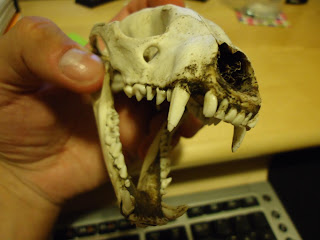
It took me awhile to figure out what this guy is. After I got back from the hospital, my assistant, Ashlee, gave me a mystery skull that her parents (in California) sent to her. They found this skull on their property, and I cleaned it up as best I could. There's still some dirt and dried skin on the mandibular symphysis. The ascending processes of the dentary are broken off, and all of the teeth are cracked in half. But hey, free skull! Can you ID it? I was tipped off by a friend much smarter than me to consult the dental formula, so that's what I suggest.

It is not a large animal. The skull is a whopping 4.5" long.

A little more dried skin that I'm afraid to pull off lest I break the bone. It's really on there.

Here's the lower jaw. Notice that it has the same dental formula as the skull!

RAWR! Actually, this animal wasn't a carnivore. I mean, it will eat meat if presented with meat. But it'll eat just about anything else, too. The wife tells me it's considered something of a pest. What is it, folks?




8 comments:
Common raccoon?
Raccoon (lulz). You need to soak it in chlorine free bleach (you can get it at Walmart) for awhile (BUT NOT regular bleach), that'll whiten it up and you'll be able to get that dried skin loose.
Nick
Raccoon? It is obviously a "Montauk Monster" skull. You just can't tell because the rest of the soft tissue is missing. I didn't know they had them in California, though.
I believe it is a badger. Also, hydrogen peroxide whitens skulls nicely if they're soaked in it for about a day, or overnight. Its not as damaging as bleach. I've been told to place the skull in the sun to dry after soaking and they'll be extra white (if that matters to you).
I'm going to guess badger also.
Can't be a badger the tooth count is wrong.
It's a Raccoon skull.
No way a badger -- badgers have a kind of crest at the back of the skull for all those muscles associated with digging.
Note the squarish molars like human molars -- omnivore teeth. Note the relatively large brain-containing part of the skull. This is definitely a raccoon.
-- Barbara
Yep, it's a raccoon. I have a raccoon skull that I keep on my desk, and they are nearly identical, though the teeth on yours are in better condition.
Post a Comment